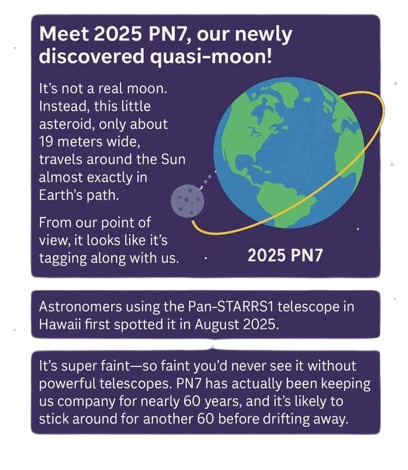
Why in the News?
Astronomers have confirmed the discovery of asteroid 2025 PN7, Earth’s latest quasi-moon.
About Quasi-Moon 2025 PN7:
- Discovery: First detected on 2 August 2025 by the Pan-STARRS 1 telescope in Hawaii; confirmed in September 2025 as Earth’s newest quasi-satellite.
- Orbit: Circles the Sun, not Earth, but remains near Earth due to a 1:1 orbital resonance – meaning it completes one solar orbit in the same time as Earth.
- Distance from Earth: At closest, ~299,000 km, similar to the Moon’s distance.
- Physical Traits: Roughly 19 metres wide, very faint (magnitude 26.4), requiring large telescopes to track.
- Orbital Parameters: Semi-major axis 1.003 AU (same as Earth), eccentricity 0.108 (slightly oval), inclination just under 2°.
- Arjuna Nature: Fits the Arjuna asteroid class criteria – extremely Earth-like orbit, low eccentricity, and low inclination, making it appear as a temporary companion.
- Stability: Expected to remain a quasi-satellite for ~128 years before shifting into another orbital configuration.
What is the Arjuna Asteroid Class?
- Overview: A rare group of near-Earth objects (NEOs) with orbits closely matching Earth’s path around the Sun.
- Etymology: Originated with the discovery of asteroid 1991 VG by astronomer Robert H. McNaught at the Siding Spring Observatory in Australia in 1991.
- Name Origin: Inspired by Arjuna from the Mahabharata – symbolising fast-moving and elusive objects.
- Special Traits:
- Can approach Earth more closely than most asteroid families.
- Sometimes become temporary mini-moons or quasi-satellites.
- Have relatively low relative velocities, making them attractive for spacecraft missions.
- Scientific Importance:
- Offer natural laboratories for studying orbital resonance and gravitational effects.
- Useful for testing asteroid mining and redirection technologies.
- Significant for planetary defence, since tracking their movements refines collision risk predictions.
| [UPSC 2023] Consider the following pairs:
Object in space – Description 1. Cepheids – Giant clouds of dust and gas in space 2. Nebulae – Stars which brighten and dim periodically 3. Pulsars – Neutron stars that, are formed when massive stars run out of fuel and collapse How many of the above pairs are correctly matched? (a) Only one * (b) Only two (c) All three (d) None |
Get an IAS/IPS ranker as your 1: 1 personal mentor for UPSC 2024

